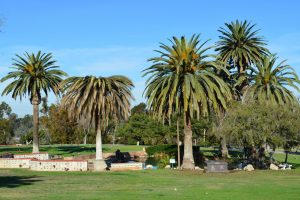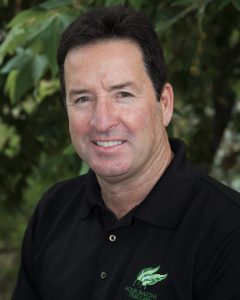We’re all familiar with tales of zombies, but the apocalypse many experts predict in Southern California is one where pests from all over the world decimate our trees. In this struggle Plant Health Care Manager Jeff Cloud is the Jon Snow (or Daryl Dixon) we want on our side. Already a Registered Consulting Arborist, Jeff has just earned his Qualified Applicator License.

Palm weevil larvae (Rhynchophorus phoenicis)
In case you hadn’t heard, Southern California’s trees are under attack by a legion of pests. Tens of millions of trees are expected to die. Years of drought, the higher salinity of recycled water, and climatic changes have made dozens of tree species susceptible to what now seems like an unstoppable army of pests that has marched into our region.
Imagine the impact of losing your largest and most valued trees, the ones that provide shade to tenants or residents, or flank the entrance to the property, the ones that cost thousands to remove….
Against the biggest offenders (shot hole borer, goldspotted oak borer, Asian citrus psyllid, glassy-winged sharpshooter, South American palm weevil), eradication strategies range from moderately effective to completely futile. The polyphagous shot hole borer alone could kill as many as 27 million, or 38%, of the trees in LA, Orange, Riverside and San Bernardino Counties. Its cousin, the Kuroshio shot hole borer, is wrecking havoc in San Diego County.

Victim of the South American palm weevil
Research testing by groups like the Center for Invasive Species Research, based at the University of California Riverside Campus, is underway to develop adequate management guidelines. Until those are discovered and made public however, preventative measures are our best weapon, especially in the case of particularly valuable or iconic trees.
To protect your trees from these numerous and seemingly unstoppable enemies you need a battle-hardened warrior and that warrior better have his QAL!
Administered by the California Department of Pesticide Regulation (DPR), the Qualified Applicator License is required to legally apply federally or state restricted use pesticides. The rigorous QAL testing process requires a near complete knowledge of the laws and regulations governing pesticide application from the local to the federal level, and ensures that these chemicals are being applied responsibly and in the most effective manner possible.
 Jeff, who manages our Plant Health Care Department, had a head start on the exam because of the pest and disease courses he took while studying horticulture at Cal Poly. Combined with his experience running the spray program during his previous career in the nursery business, and two months of concentrated individual study, he was able to complete the process and become licensed in about two months.
Jeff, who manages our Plant Health Care Department, had a head start on the exam because of the pest and disease courses he took while studying horticulture at Cal Poly. Combined with his experience running the spray program during his previous career in the nursery business, and two months of concentrated individual study, he was able to complete the process and become licensed in about two months.
We are excited to offer our customers comprehensive plant health care services under the direction of this very qualified arborist.
Additional reading and sources:
http://www.latimes.com/local/california/la-me-dying-urban-trees-20170403-story.html
http://www.sandiegouniontribune.com/news/environment/sd-me-county-pests-20170701-story.html
Center for Invasive Species Research
UC Statewide Integrated Pest Management Program
